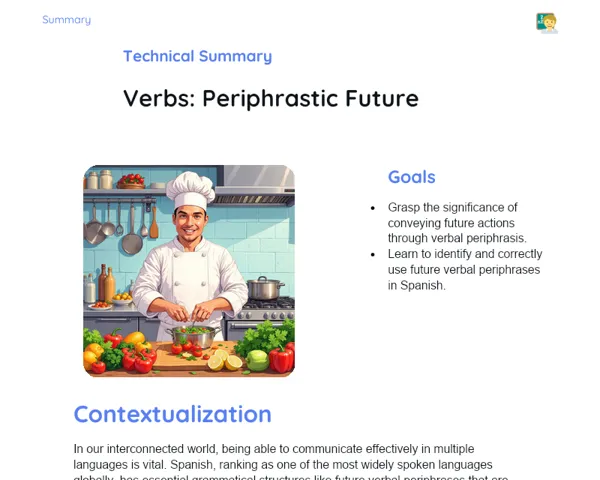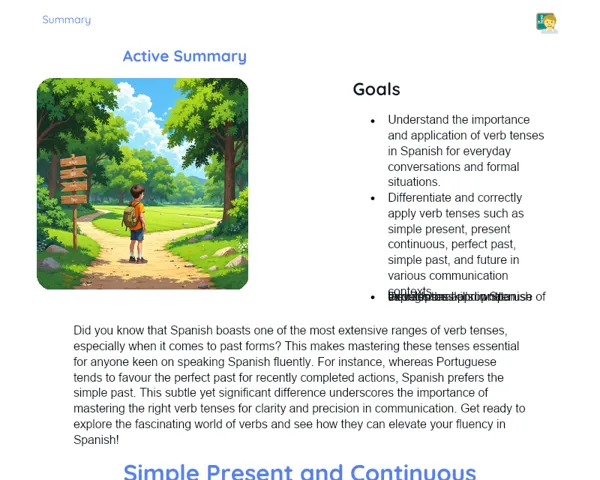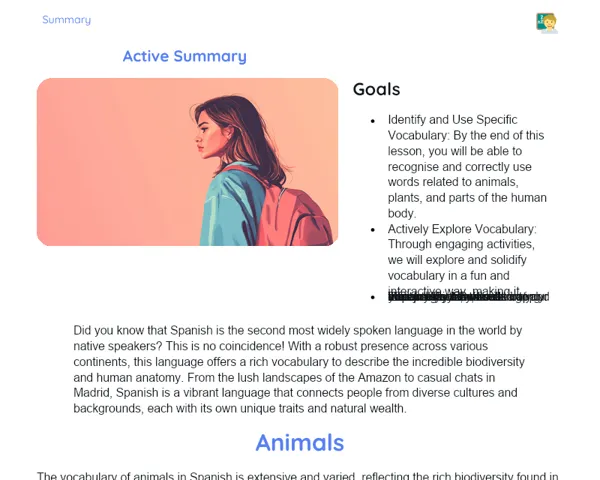Summary Tradisional | Textual Genres
Contextualization
Text genres are categories that group texts based on shared traits like structure, style, and purpose. In Afrikaans, as with any language, these genres are vital for effective communication, enabling readers and listeners to grasp the intention behind each text. It's essential for learners to understand text genres to interpret and create texts suitable for various settings and situations.
We encounter text genres in our daily lives, whether reading a news article or composing an essay. Each genre has unique traits that set it apart, such as its organization, vocabulary, and communication goals. Recognizing these traits aids students in identifying the type of text they are engaging with, enhancing both comprehension and production.
To Remember!
Definition and Importance of Text Genres
Text genres are categories of writing that share common traits in structure, style, and purpose. They are crucial for effective communication, allowing writers to organize their thoughts and readers to comprehend messages with clarity and structure. In Afrikaans, text genres play a key role in interpreting and producing texts, facilitating communication in diverse contexts.
Genres help set expectations for how a text might look and what it contains. For instance, when reading a news article, readers anticipate factual and objective information. Conversely, a fictional short story may lead to vivid descriptions and fictional plots. This predictability is essential for efficient understanding.
Additionally, knowing about text genres is vital for producing written work. When writing an essay, adhering to the appropriate structure and style for that genre is crucial to present arguments clearly. Similarly, drafting instructions requires clear and direct language so readers can grasp each step of the process.
-
Text genres are categories with shared characteristics.
-
They enhance communication and text understanding.
-
Crucial for creating context-appropriate texts.
Main Text Genres in Afrikaans
The primary text genres in Afrikaans include narrative, descriptive, argumentative, instructive, and expository. Each genre possesses distinctive characteristics that determine their suitability for varying communication objectives.
The narrative genre narrates a story, presenting a sequence of events with elements like characters, settings, and plots. Common examples include short stories, novels, and fables. The descriptive genre, however, emphasises detailing the traits of people, places, or objects, without necessarily telling a story—often seen in landscape descriptions and character profiles.
The argumentative genre presents ideas systematically and logically. It typically appears in essays, informative articles, and persuasive texts. The instructive genre is focused on guiding the reader regarding how to complete a task, seen in manuals, recipes, and guidelines. Lastly, the expository genre aims to clarify or explain a topic in an objective manner, often found in informative articles, reports, and educational materials.
-
Core text genres: narrative, descriptive, argumentative, instructive, and expository.
-
Every genre has unique characteristics for its proposed communication.
-
Narrative tells tales; descriptive reveals details; argumentative presents logical points; instructive guides; expository informs.
Practical Examples of Each Text Genre
Concrete examples are essential to illustrate the various text genres and their defining characteristics. In the narrative genre, consider an excerpt from a short story that depicts narrative structure with characters, settings, and a series of events: 'It was a gloomy evening, and the rain lashed against the windows as shadows danced in the dark.'
For the descriptive genre, a detailed portrayal of a place could highlight how characteristics are presented vividly: 'The mountain towered above, draped in a lush green cloak, while the snow on its peak glimmered beneath the bright sun, contrasting beautifully with the cerulean sky.'
An argumentative essay can showcase the argumentative genre: 'Protecting our environment is crucial for future generations. We must adopt sustainable practices to minimize pollutant emissions, ensuring a healthier planet for all.' The instructive genre could be demonstrated through a recipe: 'To prepare a chocolate cake, gather flour, sugar, eggs, butter, and cocoa powder. Start by mixing the dry ingredients...'. Lastly, the expository genre can be illustrated with an informational article: 'Solar energy is a renewable source, harnessing sunlight to generate electricity. This sustainable alternative can reduce reliance on fossil fuels and curb greenhouse gas emissions.'
-
Concrete examples clarify text genre traits.
-
Narrative genre: stories, novels; descriptive genre: landscapes, character sketches.
-
Argumentative genre: essays; instructive genre: recipes, manuals; expository genre: informational content.
Analysis of Real Texts
Examining real-world texts effectively highlights the characteristics of various genres. By analysing texts from different sources, learners can discern how features of each genre are applied in real situations.
For example, while analysing a newspaper article, students can identify the structure common to expository texts, which includes an informative headline, an introduction summarizing key details, and a body elaborating these points. They can also observe unbiased language typical of this genre.
In a narrative analysis, students can investigate the structure of storytelling by identifying characters, settings, events, and resolutions. They can evaluate how authors weave descriptions and dialogue to enhance the plot and engage the reader. This kind of analysis deepens understanding of narrative elements and distinguishes them from other genres.
The practice can extend to identifying instructive genres within manuals or recipes, noting imperative language and precise steps. This practical approach allows learners to apply theoretical classroom knowledge, cultivating their analytical and critical thinking skills when it comes to text interpretation.
-
Analysing real texts aids in identifying and understanding text genres.
-
Practical examples include newspaper pieces, short stories, manuals, and recipes.
-
Critical analysis develops analytical skills, reinforcing understanding of each genre's features.
Key Terms
-
Narrative: A genre involving storytelling that follows a sequence of events.
-
Descriptive: A genre detailing traits and features of people, places, or things.
-
Argumentative: A genre that presents ideas in a logical, structured format.
-
Instructive: A genre aiming to instruct or guide the reader in task completion.
-
Expository: A genre focused on informing or elucidating a topic clearly and objectively.
-
Structure: The arrangement and layout of different elements in a text.
-
Style: The author's unique expression in a text, including vocabulary and sentence structure.
-
Purpose: The intended goal or aim of a text.
-
Text Interpretation: The capability to comprehend and analyse a text's content and intention.
-
Text Production: The ability to create coherent texts suited to various genres and contexts.
Important Conclusions
Text genres play a crucial role in effective communication, categorizing texts with shared features in structure, style, and purpose. In Afrikaans, these genres assist in interpreting and producing texts suitable for specific situations and communicative needs. Grasping text genres enhances reading and writing, resulting in clearer and more precise communication.
In the lesson, we explored the primary text genres in Afrikaans, including narrative, descriptive, argumentative, instructive, and expository. Each genre has distinct traits that cater to different communicative goals. We studied concrete examples and real-world texts to better understand these characteristics and their practical applications.
Comprehending text genres is essential for successful text production and accurate interpretation across different formats. This understanding enables individuals to discern the author's intent and the text's message, ultimately enhancing both written and oral expressions. Ongoing exploration and practice in text analysis remain vital for deepening comprehension and developing critical and analytical skills.
Study Tips
-
Read various text types and try to identify their genres. Focus on traits like structure, language, and purpose.
-
Practice composing texts across different genres: write a short story, a descriptive essay, an argumentative piece, a recipe, and an informative article.
-
Engage in discussions about the texts you read with colleagues or peers. Sharing analyses and interpretations can broaden your understanding of text genres.



